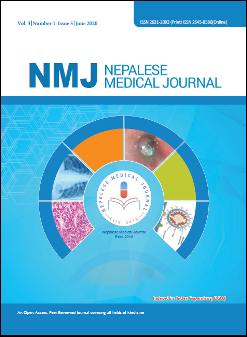Variation of Fluoroscopic Radiation Dose during Endourological Procedures for Renal Stones
DOI:
https://doi.org/10.3126/nmj.v3i1.29370Keywords:
Fluoroscopic dose, Fluoroscopic time, Percutaneous nephrolithotomy, Retrograde intrarenal surgeryAbstract
Introduction: Fluoroscopic guidance is routine for endourological procedures like percutaneous nephrolithotomy and retrograde intrarenal surgery in vast majority of centers. It is used for the initial retrograde ureteral access to define the pelvicalyceal system, puncture of the desired calyx and dilatation of the tract, aid navigation of stones and calyces, and placement of guide wires and stents. Both the patient and operating staffs are exposed to the radiation during surgery. The purpose of this study is to measure that exposed fluoroscopic radiation dose during these procedures and make operating surgeons aware of their fluoroscopic habit.
Materials and Methods: This is prospective observational study, who underwent percutaneous nephrolithotomy (n=60) and retrograde intrarenal surgery (n=43) in our institute between December 2017 and August 2018. Percutaneous nephrolithotomy was done in prone position with prior insertion of ureteric catheter. Retrograde intrarenal surgery was carried out with or without insertion of ureteral access sheath. Fluoroscopic time was taken from the insertion of the ureteric catheter or UAS to the completion of the procedure with double J stenting.
Results: For percutaneous nephrolithotomy and retrograde intrarenal surgery group, mean stone size were 21.89 mm and 10.56 mm; mean fluoroscopic time were 117.95 s (range 24-350) and 31.83 s (range 3-103); mean fluoroscopic dose were 29.71 mGy and 6.19 mGy respectively.
Introduction: Fluoroscopic guidance is routine for endourological procedures like percutaneous nephrolithotomy and retrograde intrarenal surgery in vast majority of centers. It is used for the initial retrograde ureteral access to define the pelvicalyceal system, puncture of the desired calyx and dilatation of the tract, aid navigation of stones and calyces, and placement of guide wires and stents. Both the patient and operating staffs are exposed to the radiation during surgery. The purpose of this study is to measure that exposed fluoroscopic radiation dose during these procedures and make operating surgeons aware of their fluoroscopic habit.
Materials and Methods: This is prospective observational study, who underwent percutaneous nephrolithotomy (n=60) and retrograde intrarenal surgery (n=43) in our institute between December 2017 and August 2018. Percutaneous nephrolithotomy was done in prone position with prior insertion of ureteric catheter. Retrograde intrarenal surgery was carried out with or without insertion of ureteral access sheath. Fluoroscopic time was taken from the insertion of the ureteric catheter or UAS to the completion of the procedure with double J stenting.
Results: For percutaneous nephrolithotomy and retrograde intrarenal surgery group, mean stone size were 21.89 mm and 10.56 mm; mean fluoroscopic time were 117.95 s (range 24-350) and 31.83 s (range 3-103); mean fluoroscopic dose were 29.71 mGy and 6.19 mGy respectively.
Conclusions: Among the endourological procedures for renal stones, retrograde intrarenal surgery was associated with less fluoroscopic hazard than percutaneous nephrolithotomy. Awareness of fluoroscopic exposure duration and experience of a surgeon can minimize the radiation hazard during endourological procedures.
Downloads
Downloads
Published
How to Cite
Issue
Section
License
This license enables reusers to distribute, remix, adapt, and build upon the material in any medium or format, so long as attribution is given to the creator. The license allows for commercial use.
Copyright on any article published by Nepalese Medical Journal is retained by the author(s).
Authors grant Nepalese Medical Journal a license to publish the article and identify itself as the original publisher.
Authors also grant any third party the right to use the article freely as long as its integrity is maintained and its original authors, citation details and publisher are identified.




